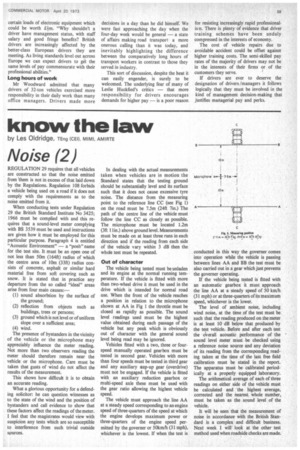know the law
Page 61

If you've noticed an error in this article please click here to report it so we can fix it.
by Les Oldridge, TEng (CEO. MIMI, AMIRTE Noise (2) 10m
REGULATION 29 requires that all vehicles are constructed so that the noise emitted from 'them is not in excess of that laid down by the Regulations. Regulation 108 forbids a vehicle being used on a road if it does not comply with the requirements as to the noise emitted from it.
When conducting tests under Regulation 29 the British Standard Institute No 3425; 1966 must be complied with and this requires that a sound-level meter complying with BS 3539 must be used and instructions are given how it must be employed for this particular purpose. Paragraph 4 is entitled "Acoustic Environment" — a "posh" name for the test site. It must be an open one of not less than 50rn (164ft) radius of which the centre area of 10m (33ft) radius consists of concrete, asphalt or similar hard material free from soft covering such as snow. It is stated that in practice any departure from the so called "ideal" areas arise from four main causes:—
(I) sound absorbtion by the surface of the ground; (2) reflection from objects such as buildings, trees or persons; (3) ground which is not level or of uniform slope over a sufficient area; (4) wind.
The presence of bystanders in the vicinity of the vehicle or the microphone may appreciably influence the meter reading. Not more than two observers reading the meter should therefore remain near the vehicle or the microphone. Care must be taken that gusts of wind do not affect the results of the measurement.
This shows how difficult it is to obtain an accurate reading.
What a glorious opportunity for a defending solicitor: he can question witnesses as to the state of the wind and the position of bystanders and call evidence to show that these factors affect the readings of the meter. I feel that the magistrates would view with suspicion any tests which are so susceptible to interference from such trivial outside
SPLIrCeS.
In dealing with the actual measurements taken when vehicles are in motion the Standard states that the testing ground should be substantially level and its surface such that it does not cause excessive tyre noise. The distance from the measuring point to the reference line CC (see Fig 1) on the road must be 7.5m (24ft 7in.) The path of the centre line of the vehicle must follow the line CC as closely as possible. The microphone must be located 1.2m (3ft 1 lin.) above ground level. Measurements must be made on at least three runs in each direction and if the reading from each side of the vehicle vary within 3 dB then the whole test must be repeated.
Out of character The vehicle being tested must be unladen and its engine at the normal running temperature. If the vehicle is fitted with more than two-wheel drive it must be used in the drive which is intended for normal road use. When the front of the vehicle reaches a position in relation to the microphone shown at AA in Fig 1 the throttle must be closed as rapidly as possible. The sound level readings used must be the highest value obtained during each passage of the vehicle but any peak which is obviously out of character with the general sound level being read may be ignored.
Vehicles fitted with a two, three or fourspeed manually operated gearbox must be tested in second gear. Vehicles with more than four speeds must be tested in third gear and any auxiliary step-up gear (overdrive) must not be engaged. If the vehicle is fitted with an auxiliary reduction gearbox or multi-speed axle these must be used with the gear ratio allowing the highest vehicle speed.
The vehicle must approach the line AA at a steady speed corresponding to an engine speed of three-quarters of the speed at which the engine develops maximum power or three-quarters of the engine speed permitted by the govemer or 50km/h (31 mph), whichever is the lowest. If when the test is conducted in this way the govemer comes into operation while the vehicle is passing between lines AA and BB the test must be also carried out in a gear which just prevents the governer operating.
If the vehicle being tested is fitted with an automatic gearbox it must approach the line AA at a steady speed of 50 km/h (31 mph) or at three-quarters of its maximum speed, whichever is the lower.
The level of ambient noise, including wind noise, at the time of the test must be such that the reading produced on the meter is at least 10 dB below that produced by the test vehicle. Before and after each test the Overall acoustic performance of the sound level meter must be checked using a reference noise source and any deviation of its reading from the corresponding reading taken at the time of the last free field calibration must be stated in the report. The apparatus must be calibrated periodically at a properly equipped laboratory.
The arithmetical average of each of three readings on either side of the vehicle must be calculated and the highest average, corrected and the nearest whole number, must be taken as the sound level of the vehicle.
It will be seen that the measurement of noise in accordance with the British Standard is a complex and difficult business. Next week I will look at the other test method used when roadside checks are made.




































































































